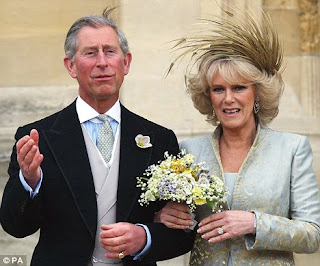 Breaking with tradition: Prince William will not be wearing a wedding ring after his marriage to Kate Middleton on April 29
Breaking with tradition: Prince William will not be wearing a wedding ring after his marriage to Kate Middleton on April 29Prince William has decided not to wear a wedding ring following his marriage to Kate Middleton, palace officials have revealed.
According to senior royal sources, the Prince discussed the issue with his fiancée but has chosen not to. 'It is simply down to personal preference,' an aide said.
Kate, 29, will wear a band fashioned from a lump of Welsh gold already owned by the Royal Family which will be given to her in the traditional way during the April 29 Westminster Abbey wedding ceremony, the Mail can reveal.
The use of Welsh gold in royal wedding bands is a long-standing tradition.
Most male royals do wear a wedding ring of some kind, with the exception of the Duke of Edinburgh.
Like many members of the upper classes, Prince Charles wears a gold wedding ring under a signet ring on the little finger of his left hand given to him by the Duchess of Cornwall.
His signet ring bears the fleur-de-lys crest of the Prince of Wales and is believed to have been a gift from his parents.
He also wore a ring given to him by his first wife, Diana, Princess of Wales, until the day after his engagement to Camilla.
William's decision not to sport a wedding band is likely to cause some surprise, however, as it is so commonplace nowadays.
 Symbol: Prince Charles wears a wedding ring under a signet ring on the little finger of his left hand given to him by the Duchess of Cornwall, who he married in 2005
Symbol: Prince Charles wears a wedding ring under a signet ring on the little finger of his left hand given to him by the Duchess of Cornwall, who he married in 2005But a St James's Palace aide insisted that it was a decision that Kate was happy with.
'It was something the couple discussed but Prince William isn't one for jewellery - he doesn't even wear a signet ring - and decided he didn't want to. It really is just down to personal preference,' they said.
'Catherine will wear a ring fashioned from a lump of Welsh gold owned by the Royal Family that has been smelted down. The couple have both had a hand in the design.
This is the ring Prince Harry will carry and hand over in the traditional way.'
Another source added: 'It is quite common for men in that strata of society not to wear a traditional wedding band. If they do, they tend to wear it with their family signet ring but William doesn't have one of those.'
 Most male royals, including Prince Edward (left), do wear a wedding ring of some kind, with the exception of the Duke of Edinburgh (right)
Most male royals, including Prince Edward (left), do wear a wedding ring of some kind, with the exception of the Duke of Edinburgh (right)Prior to the Second World War is was unheard of for men to wear wedding rings. It then became customary for soldiers serving overseas to wear a wedding band to remind them of home and their commitment to their wives and families.
The popularity of wedding rings for men has since soared, but there is still divided opinion on whether wearing one is obligatory or not.
Although wearing a wedding ring for men in the past was not crucial, most modern brides would not hear of her new husband’s fourth finger going unadorned.
David Miller, director of Debretts, a leading authority on etiquette, said: 'Wearing a wedding ring used to be uncommon for men but now it is quite accepted practice.
That said, it really is a matter of personal choice and members of the Royal Family often chose to wear it with a signet ring on the little finger of their left hand.
'Although this is a very modern royal wedding in so many ways, I think there will be a few surprises of this kind to come.'
According to some customs, the wedding ring forms the last in a series of gifts, which also may include the engagement ring, traditionally given as a betrothal present. This tradition was already in use in Ancient Rome and is possibly much older.
After marriage, the ring is worn on the hand it had been placed on during the ceremony. By wearing rings on the fourth finger, a married couple symbolically declares their eternal love for each other.
source:dailymail
No comments:
Post a Comment